|
|
Prominent Cricopharyngeus
Cricopharyngeal Bar, Cricopharyngeal Achalasia
- Lies at the junction of the hypopharynx and cervical esophagus, posteriorly at about the level of C5-C6
- The cricopharyngeus muscle is part of the upper esophageal sphincter mechanism
- The cricopharyngeus muscle is normally contracted at rest
- Upon the initiation of swallowing, the normal cricopharyngeus muscle relaxes in anticipation of the bolus and helps to form part of the pharyngeal peristaltic wave
- Therefore, the cricopharyngeus muscle is usually not seen on a barium swallow
- A prominent cricopharyngeus, however, can be seen on barium swallows in about 5-10% of asymptomatic individuals
- It appears as a smooth, posterior bar or band-like protrusion into the barium column on the lateral view
- It is typically demonstrated best on a video fluoroscopic swallowing study but it can be seen in the lateral projection on a barium swallow
- Such prominence in asymptomatic patients is of unknown clinical significance
- May be related to occult gastroesophageal reflux (GERD)
- Others who demonstrate a prominent cricopharyngeus on barium swallow may complain of dysphagia or a "lump in the throat"
- The cricopharyngeal prominence can be due to delayed or incomplete opening of the cricopharyngeus, or to early closure
- In symptomatic patients, a prominent cricopharyngeus may be due to neurologic diseases that cause pharyngeal paresis (CVA), muscular diseases (myasthenia gravis, dermatomyositis) or be a compensatory response, usually to gastroesophageal reflux
- The increased resting tone of the cricopharyngeus muscle has been implicated in the formation of a Zenker(‘s) diverticulum
- A Zenker’s diverticulum forms posteriorly in the space (Killian’s dehiscence) between the cricopharyngeus muscle and the inferior esophageal constrictor muscles
- Treatment
- Treatment of cricopharyngeal spasm can include management of the patient’s GERD or injection of Botox into the muscle
- Cricopharyngeal myotomy has been performed to surgically eliminate the cricopharyngeus as a cause of obstruction

Prominent cricopharyngeus muscle. The blue arrow points to a posterior, bar-like protrusion at the level of
C5-C6 that represents a prominent cricopharyngeus muscle. Usually relaxed on swallowing in asymptomatic individuals,
the cricopharyngeus is not visible on a normal barium swallow.
The white arrows point to disordered tertiary waves of contraction.
For the same photo without the arrows, click here
|
|
|